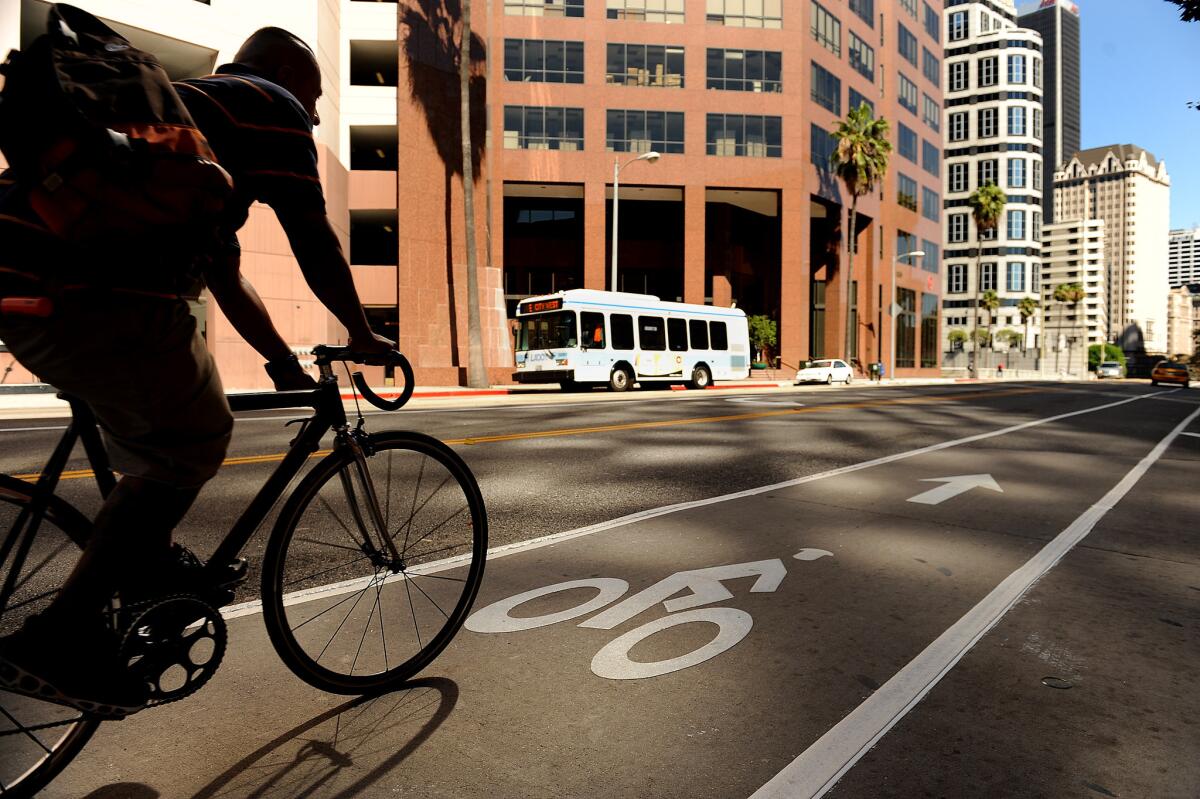San Diego’s streets are about to become a lot more bike-friendly

- Share via
Reporting from San Diego — Cars will have to share downtown San Diego’s streets much more with bicyclists and pedestrians under an ambitious plan that aims to boost safety and fight climate change.
The proposal, which the City Council unanimously approved this week, would transform many vehicle lanes and some on-street parking into miles of protected cycling lanes and pedestrian promenades.
San Diego is joining a growing list of cities trying to revamp their streets to make cycling safer and more convenient, primarily because more bicycle commuting is considered crucial to reducing greenhouse gas emissions linked to climate change.
“The public owns our streets,” said Stephen Haase, vice chairman of the San Diego Planning Commission. “It’s time to give pedestrians and cyclists equal priority with the almighty car.”
The so-called Downtown Mobility Plan has met some resistance from community leaders in connection with lost parking spots and the locations of some protected cycling lanes.
Officials stress that the routes chosen are the most ideal based on safety, convenience, connectivity and the goal of minimizing lost parking.
They also note that the plan actually increases downtown parking spaces in its first 10 years, thanks to hundreds of parallel-parking spots being converted to angled parking.
Over the 30-year duration of the plan, parking would decrease by 477 spots from the approximately 9,000 now available downtown.
The public owns our streets. It’s time to give pedestrians and cyclists equal priority with the almighty car.
— Stephen Haase, vice chairman of the San Diego Planning Commission.
The plan, estimated to cost $62.5 million over 30 years, is supported by the local business community.
“The efficiency of our transportation network is directly connected to the efficiency of our economy,” said Sean Karafin of the San Diego Regional Chamber of Commerce.
The proposal also would also help the city achieve some of the goals in the Climate Action Plan adopted by the council last year.
It requires the number of people bicycling to work in San Diego’s densely populated neighborhoods to increase from 2% to 6% by 2020, and then to 18% by 2035..
Nicole Capretz, primary author of the Climate Action Plan, said the mobility plan was a big step because downtown is a crucial part of San Diego that sets the tone for other neighborhoods.
“This is an incredible moment for our city,” she said.
Another environmental group, however, said the plan doesn’t focus enough on boosting mass transit in downtown, which has several trolley stops and serves as the endpoint of several express bus routes.
“We want to thank you for the fantastic bike and walk components of the plan, but unfortunately this plan is a disaster,” said Jana Clark, secretary of the Cleveland National Forest Foundation. “A mobility plan without transit is not a mobility plan.”
City officials have said transit upgrades, while important, are not within the scope of the mobility plan. The focus instead has been on cycling routes, said Brad Richter, assistant vice president of planning at Civic San Diego.
“We have very limited bicycle infrastructure in the downtown area,” Richter said. “Either people don’t feel safe bicycling or they ride on our public sidewalks, which creates safety hazards.”
Richter said the plan includes concepts — borrowed from Long Beach, New York and Seattle, among other cities — such as cycle tracks, where one lane of the street is segregated from the rest to create a safe space for riders.
Andy Hanshaw, executive director of the San Diego County Bicycle Coalition, said the changes would benefit everyone, not just avid cyclists.
“This network will serve all residents, employees and tourists,” said Hanshaw, noting that the downtown cycle tracks were strategically placed to connect to bike paths in surrounding cities and communities.
The plan also includes some greenways, or pedestrian promenades, where a road lane previously used for parking or travel would become a landscaped area designed for pedestrians and socializing.
Kathleen Ferrier of the pedestrian advocacy group Circulate San Diego praised the plan.
“It will improve mobility choices by what we call ‘right sizing’ the streets — by using the extra capacity that exists now for cars to make way for people walking and biking,” she said. “It will improve safety and get more people out of their cars and on their feet and their bicycles.”
david.garrick@sduniontribune.com
Garrick writes for the San Diego Union-Tribune.
More to Read
Sign up for Essential California
The most important California stories and recommendations in your inbox every morning.
You may occasionally receive promotional content from the Los Angeles Times.













